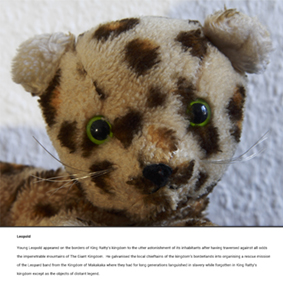Robert Frankle
- Home
- News
-
-
- Castlefield Canals
- Checking
- La Chiave al Posto Suo
- Chronicle of a Pandemic Foretold
- Conversing with Colored Cloth
- Eau de Venise
- Elasticity
- Exurbia
- Fear
- First Gaze
- Icons of the Time
- IN Salford
- Mage of Manchester
- Malecon
- Narcissus
- On
- Pandemonium
- Pounding
- Park St
- Press Room
- Rebecca
- Salford Exchange
- Scars
- Sorting
- Succession
- Teddy
- Toil
- Trumpty Dumpty
- Virtually Fusioun
- Washing
- 49° 36' 35"N 6° 8' 5"E The Wall (archives)
- 49° 36' 14"N 6° 87' 15"E Schwaartzhaus
-
-
-
- Texts +
- CV
- Biography
- Contact
- Links
embracing the echo
Master's Research Paper by Birgit Thalau
2020

Extract from pages 25-26
3.4. Example from contemporary art
Currently, artists still make use of everyday and fetish objects to express themselves.
In his photo series Teddy, Fantasy (first part) and Reality (second part) 1, from 2010, the American-Luxembourgish artist Robert Frankle presents "plushies" and their stories. "As part of each image, I reveal a small story that constitutes part of our common identity and my personal story" 2, he explains.
This statement relates to the theories that I have presented and, as a result, I chose this example for my essay. Starting with his own experience, the artist recounts something about objects that typically accompany us as children and help fulfil our "needs".
As generally perceived, the teddy bear's status is one of a cultural agent of childhood innocence, a fetish for comfort (due to the feel of the material - soft, snug, cuddly fabric, an intimate familiarity, perhaps even from the smell) and security (something you can hold on to). Beside thes fetish, I am also reminded of the term "transitional object" introduced in 1951 by Donald Winnicott 3 as "any material object (typically something soft - a piece of cloth, say, or part of a plush toy) to which an infant would attribute a special value and by means of which the child is able to make the necessary shift from the earliest relationship with the mother to genuine object - relationships" 4.
These personal objects are usually not defined by their material value, but by their social attribution. They carry us through life and our own history (like my grandfather's wooden box, which I described in the introduction).
Looking closer at the photos and texts, I feel quite receptive to the work's approach that suggests a feeling between anxiety and the enchantment coming from a child's perspective. This leads my emotions to come through.
Obviously, there is a strong reason why the artist chose these objects. I know that Robert Frankle was abandoned by his teenage parents and raised by adoptive parents and is today still struggling with the fear of rejection. As if to reclaim his childhood life, he imagines individual events for cuddly toys, on the borderline between fictional (as a child might perceive them, but also in the way our thinking functions) and real (hints at historical backgrounds).
By displaying only photographs of teddy bears, the artist refers to his past and challenges as well as the affective character of the object and its materiality. Regarded from an adult's viewpoint, the term "teddy" becomes more multifaceted, adaptable and is manipulated because it is observed from a distance providing more than a sense of emotional security and the child's fetish.
There is not a singular interpretation of what relations between humans and things can be. Moreover, they are definitely not based purely on rational relationships either. For me, this artistic work is touching as it represents a tough reality, but also carries the intention of an enchanted aura. It plays with archetypes and still betrays a poetic side to the observer. Here, art can help to build a bridge to reconciliation within our personal limits (in this case, adult redemption).
1. Artist's website: Teddy on robertfrankle.com (accessed 08.10.2020) ↩2. Carrière, Mylène: Robert Frankle à Dudelange: son rempart contre l'abandon, Le Quotidien, Luxembourg, 2016: (accessed 08.10.2020) ↩
3. British paediatrician and psychoanalyst, especially influential in the field of object relations theory and developmental psychology. ↩
4. Scheimberg, Nora, Transitional Object: (accessed 08.10.2020) ↩